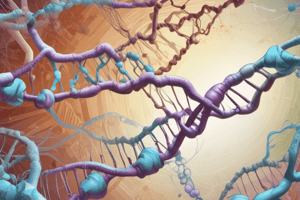Podcast
Questions and Answers
¿Cuál es el papel de los activadores en la regulación de la expresión génica?
¿Cuál es el papel de los activadores en la regulación de la expresión génica?
Los activadores promueven la transcripción reclutando el complejo de RNA polimerasa al región promotora del gen.
¿Cómo funcionan los repressores en la regulación de la expresión génica?
¿Cómo funcionan los repressores en la regulación de la expresión génica?
Los repressores bloquean la transcripción impidiendo la formación del complejo de transcripción activo.
¿Qué es un modificador epigenético y cómo influye en la expresión génica?
¿Qué es un modificador epigenético y cómo influye en la expresión génica?
Un modificador epigenético es una modificación química que altera la expresión génica sin cambiar la secuencia de ADN subyacente, influyendo en la accesibilidad de la información genética para la máquina de transcripción.
¿Cuál es el papel de la remodelación de la cromatina en la regulación de la expresión génica?
¿Cuál es el papel de la remodelación de la cromatina en la regulación de la expresión génica?
¿Cómo se logra la interferencia de RNA en la regulación de la expresión génica?
¿Cómo se logra la interferencia de RNA en la regulación de la expresión génica?
¿Cómo se puede regular la expresión génica mediante la modificación epigenética?
¿Cómo se puede regular la expresión génica mediante la modificación epigenética?
¿Cuál es el propósito de la silenciamiento génico y cómo se logra?
¿Cuál es el propósito de la silenciamiento génico y cómo se logra?
¿Cuál es la función de la remodelación del cromatina en la regulación de la expresión génica?
¿Cuál es la función de la remodelación del cromatina en la regulación de la expresión génica?
¿Cuál es el papel del ARN interferente en la regulación de la expresión génica?
¿Cuál es el papel del ARN interferente en la regulación de la expresión génica?
¿Cómo se relacionan los factores de transcripción con la modificación epigenética y la remodelación del cromatina en la regulación de la expresión génica?
¿Cómo se relacionan los factores de transcripción con la modificación epigenética y la remodelación del cromatina en la regulación de la expresión génica?
Study Notes
Gene Expression Regulation
Gene expression is a highly regulated process that involves the controlled expression of genes in response to various stimuli, environmental cues, and developmental stages. This regulation ensures that genes are only expressed when and where they are needed, allowing cells to maintain their specific functions and characteristics. In this article, we will discuss the mechanisms of gene expression regulation, focusing on transcription factors, epigenetic modification, gene silencing, chromatin remodeling, and RNA interference.
Transcription Factors
Transcription factors (TFs) are proteins that bind to specific DNA sequences in or near a gene, promoting or repressing its transcription into an RNA molecule. These proteins play a crucial role in gene regulation, as they control which genes are expressed in a given cell type or under specific conditions. TFs can be classified into three categories: activators, repressors, and enhancers. Activators promote transcription by recruiting the RNA polymerase complex to the promoter region of the gene, while repressors block transcription by preventing the formation of the active transcription complex. Enhancers are DNA sequences that can be located far away from the gene they regulate but still interact with the promoter region, modulating the transcription of the gene.
Epigenetic Modification
Epigenetic modifications refer to changes in the chromatin structure that do not involve alterations to the DNA sequence itself. These modifications can be heritable and can impact gene expression without changing the DNA sequence. Epigenetic modifications include DNA methylation, histone modifications (e.g., acetylation, methylation), and non-coding RNA-mediated regulation (e.g., microRNAs). These modifications can either activate or repress gene expression by altering the accessibility of the chromatin and the binding of transcription factors to the DNA.
Gene Silencing
Gene silencing is a process that leads to the inactivation of gene expression. Two main types of gene silencing exist: post-transcriptional gene silencing (PTGS) and transcriptional gene silencing (TGS). PTGS is mediated by small RNA molecules (e.g., microRNAs, small interfering RNAs) that target specific mRNA molecules for degradation, thus preventing their translation into proteins. TGS, on the other hand, involves the repression of gene transcription, often by the action of histone-modifying enzymes that alter the chromatin structure and make the gene inaccessible to transcription factors.
Chromatin Remodeling
Chromatin remodeling refers to the alteration of the chromatin structure, which can either promote or repress gene expression. This process involves the rearrangement of nucleosome positions and the modification of histone proteins, leading to changes in the accessibility of the DNA to transcription factors and the RNA polymerase complex. Chromatin remodeling is a crucial aspect of gene expression regulation, as it allows for the fine-tuning of gene expression in response to various stimuli and developmental stages.
RNA Interference
RNA interference (RNAi) is a process that involves the degradation of specific mRNA molecules by small RNA molecules (e.g., small interfering RNAs, microRNAs). RNAi is a conserved cellular mechanism that plays a crucial role in gene regulation by silencing specific genes and modulating gene expression. RNAi can be triggered by exogenous small RNAs (e.g., those introduced by viruses) or endogenous small RNAs (e.g., those generated from repetitive genomic elements or from certain types of genes).
In conclusion, gene expression regulation is a complex and multifaceted process that involves various mechanisms and factors. Transcription factors, epigenetic modifications, gene silencing, chromatin remodeling, and RNA interference are all essential components of this regulatory system, allowing cells to maintain their specific functions and characteristics while adapting to changing environmental and developmental conditions.
Studying That Suits You
Use AI to generate personalized quizzes and flashcards to suit your learning preferences.
Description
Explore the complex mechanisms of gene expression regulation, including transcription factors, epigenetic modification, gene silencing, chromatin remodeling, and RNA interference. Learn how these processes ensure that genes are expressed only when and where they are needed.




